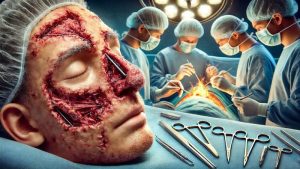Damaged nasal repair due to severe burns
Introduction
Severe face burns, especially in the area Nose, Creating serious medical, aesthetic, and psychological challenges for patients. The nose is severely exposed to damage caused by thermal, chemical or electrical burns due to a prominent position on the face.. Severe damage to the nose can cause skin loss, cartilage, and even bone structure that can lead to permanent deformation, disruption of respiratory function, and reduced patient's quality of life.. Nasal reconstruction in these patients is a complex and multi -step process that requires high skills of plastic surgeon and advanced surgical techniques..
In this article from the site of Dr. Behnam Khorrami (Isfahan nose surgeon _ Jaw surgeon of Isfahan), We will examine the various stages of nasal reconstruction, the challenges related to this process, and the common techniques used in patients with severe burns..
Causes and mechanisms of nose damage due to burns
1. Heat burns
Caused by direct contact with flame, hot steam or hot objects
Destruction of the layers of the skin and nose
In severe cases, damage to the cartilage and nasal bone
2. Chemical burns
Exposure to corrosive materials such as acids and bases
Deeper destruction of soft and bone tissues
Necrosis (Tissue death) Wide
3. Electric burns
Damage caused by high -intensity electric current
Imperfect
Damage to the nerves and blood vessels
4. Radiation burns (Radiation)
Long -term exposure to radioactive beams
Damage to superficial and deep tissues
Reducing the capacity of normal regeneration of tissue
The effects caused by damage to the nose
Defect in respiratory function:
Air route blockage due to deformation of cartilage and soft tissues
Chronic infections:
Nasal mucosal destruction, decreased natural defense system and increased risk of infection
Appearance:
Abdomen (SCAR) Wide
Psychological problems:
Reducing self -esteem and social problems due to the deformation of the nose
The initial assessment of the patient
1. Clinical review
A complete nose examination to evaluate the amount of injury
Investigating Air Ducts and Respiratory Performance
Evaluation of appearance and tissue changes
2. Medical imaging
CT scan: To evaluate damage to cartilage and bone
MRI: The examination of soft tissues and depth of burns
Angiography: Assessing blood flow in the nose
3. Functional experiments
Spirometer to check the respiratory function
Checking the opening of airways
Steps of nose reconstruction
1. Primary preparation
Cleansing necrotic tissues (Dead)
Antibiotic Infection Control
Use of special dressings (Like silicone dressings)
Providing hemodynamic stability (The stability of the patient's general condition)
2. Soft tissue regeneration
(A)) Skin transplant (Skin Grafting):
Use healthy skin from other parts of the body (Such as forehead, arm or thighs)
Bond in multiple layers to regenerate depth and flexibility
The use of perfect skin (Full Thickness Skin Graft) For better results
(B)) Skin flaps (Skin Flaps):
Use topical or free flaps to regenerate nose skin
Forehead flap (Forehead Flap) One of the common methods in nose reconstruction
Creating blood vessels in the flap to improve survival and tissue growth
3. Reconstruction of the cartilage structure
(A)) Rather, it is enlarging the nose by creating a bridge over the nose:
The use of gear cartilage, 爻倬鬲賵賲 (Septum) Or ear
Creating a strong structure to maintain nose shape
Cartilage Stabilization with delicate sutures
(B)) Reconstruction of nasal valves:
Use cartilage to open air paths
Stabilization of the inner and outer nose
4. Reconstruction of the bone skeleton
Regeneration of nasal bones using rib or skull
In severe cases, the use of artificial implants (Titanium or polyethylene)
Bone fixation with small plates and screws
5. Oscar correction and improvement of appearance
In Magazine (Dermabrasion): Reduce the thickness of the scars
Filler Injection: Improvement of the shape and volume of the nose
Laser therapy: Reduce Oscar pigments and improve the appearance of tissues
New techniques in nose reconstruction
1. Stem cell transplantation
Use stem cells to accelerate tissue regeneration
Improves blood supply and reduces inflammation
Stimulate the growth of new cells in the affected area
2. 3D printing (3D Printing):
Design and construction of high precision nose molds
The use of biofuels to rebuild the nasal structure
Reduce the duration of surgery and improve the accuracy of the results
3. Biological implants (Biologic Implants):
Using bio -matrix to rebuild the structure of tissue
Stimulate the natural growth of cells at the location of the transplantation
Possible side effects
The infection: Due to the decline in immune defense in the damaged tissue
Bond backing: Disapproval of skin or cartilage transplantation
Asymmetry: Due to the incomplete healing process
Aerial route tightness: Adhesion of tissue
Clinical results and improvement of performance
Successful nasal reconstruction improves respiratory function and patient appearance.
Increasing self -esteem and improving the quality of life after surgery
Back to day -to -day activities with minimal limitations
Conclusion
Nose reconstruction in patients with severe burns is a major challenge in plastic and reconstructive surgery. Success in this process depends on the accurate evaluation of the extent of injury, proper planning, and the use of advanced surgical techniques. Combining a variety of methods, including skin transplantation, cartilage regeneration, and the use of modern technologies such as 3D printing, can have great aesthetic and functional results..
Useful links:
Isfahan nose surgeon _ Jaw surgeon of Isfahan
Dr. Behnam Khorrami's page in the clinic 24 | Maxillofacial surgeon in Isfahan clinic 24 | Nose surgeon in Isfahan clinic 24
Dr. Behnam Khorrami, nose surgeon in Isfahan at Dr. Af | Maxillofacial surgeon in Isfahan at Dr. Af | Isfahan nose surgeon at Dr. Af
